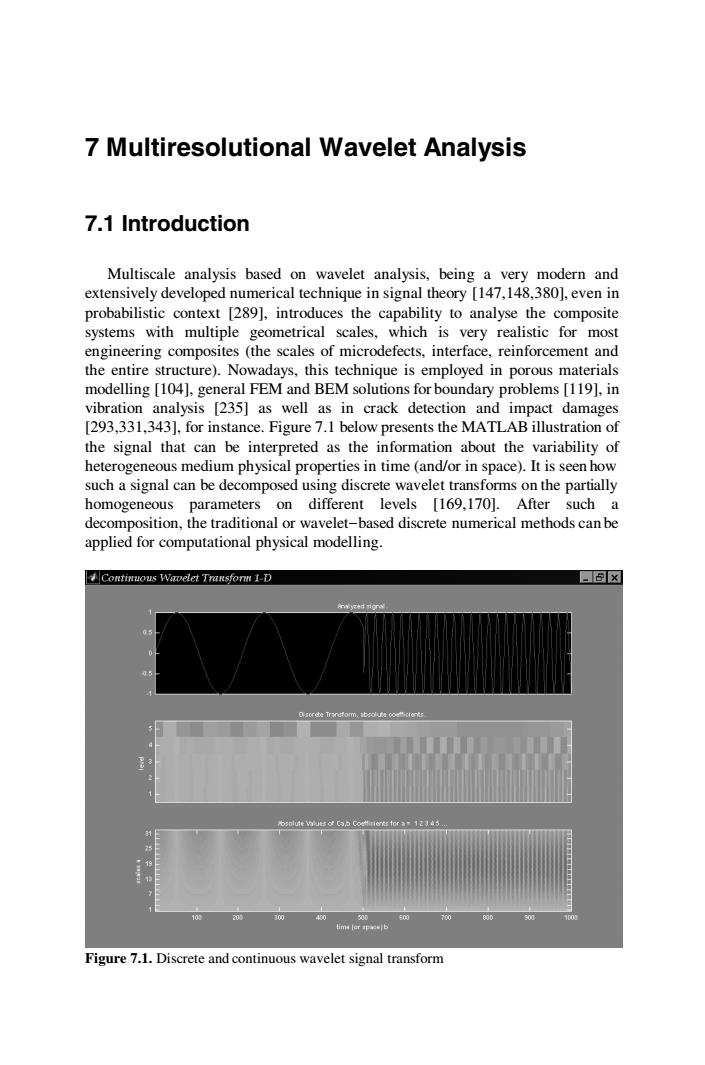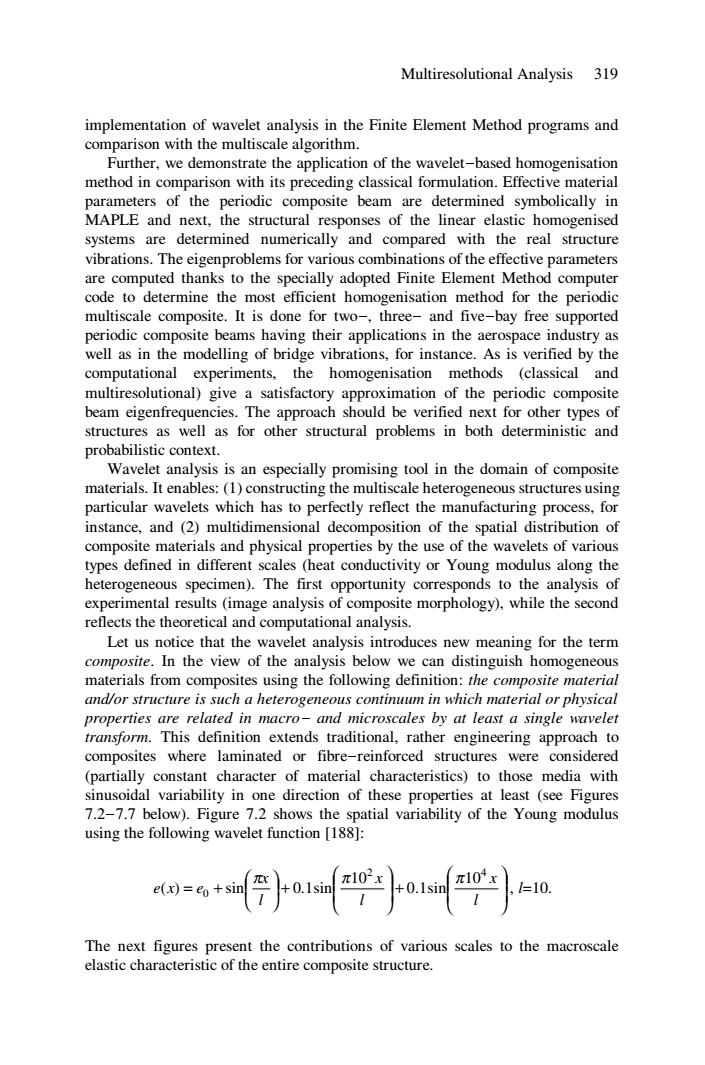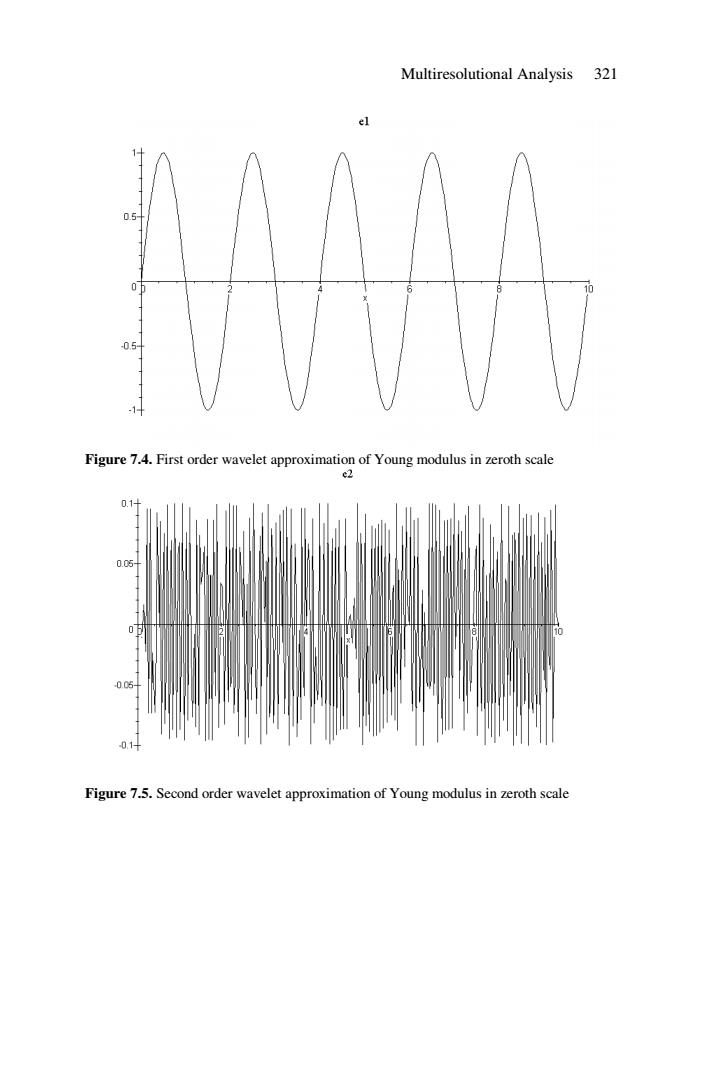
7 Multiresolutional Wavelet Analysis 7.1 Introduction Multiscale analysis based on wavelet analysis,being a very modern and extensively developed numerical technique in signal theory [147,148,380],even in probabilistic context [289],introduces the capability to analyse the composite systems with multiple geometrical scales,which is very realistic for most engineering composites (the scales of microdefects,interface,reinforcement and the entire structure).Nowadays,this technique is employed in porous materials modelling [104],general FEM and BEM solutions for boundary problems [119],in vibration analysis [235]as well as in crack detection and impact damages [293,331,343],for instance.Figure 7.1 below presents the MATLAB illustration of the signal that can be interpreted as the information about the variability of heterogeneous medium physical properties in time(and/or in space).It is seen how such a signal can be decomposed using discrete wavelet transforms on the partially homogeneous parameters on different levels [169,170].After such a decomposition,the traditional or wavelet-based discrete numerical methods can be applied for computational physical modelling Continuous Wavelet Transfonn I-D 国x☒ scr过eTrarefom.tt4c0e"比teks time ler家*b Figure 7.1.Discrete and continuous wavelet signal transform
7 Multiresolutional Wavelet Analysis 7.1 Introduction Multiscale analysis based on wavelet analysis, being a very modern and extensively developed numerical technique in signal theory [147,148,380], even in probabilistic context [289], introduces the capability to analyse the composite systems with multiple geometrical scales, which is very realistic for most engineering composites (the scales of microdefects, interface, reinforcement and the entire structure). Nowadays, this technique is employed in porous materials modelling [104], general FEM and BEM solutions for boundary problems [119], in vibration analysis [235] as well as in crack detection and impact damages [293,331,343], for instance. Figure 7.1 below presents the MATLAB illustration of the signal that can be interpreted as the information about the variability of heterogeneous medium physical properties in time (and/or in space). It is seen how such a signal can be decomposed using discrete wavelet transforms on the partially homogeneous parameters on different levels [169,170]. After such a decomposition, the traditional or wavelet-based discrete numerical methods can be applied for computational physical modelling. Figure 7.1. Discrete and continuous wavelet signal transform

318 Computational Mechanics of Composite Materials The homogenisation method is still the most efficient way of computational modelling of composite systems.Usually it is assumed that there exists some scale relation between composite components and the entire system-two scales are introduced that are related by a scale parameter being some small real value tending most frequently to 0.An essential disadvantage of all these techniques is the impossibility of sensitivity analysis of composite homogenised characteristics with respect to geometrical scales relations. Wavelet analysis became very popular in the area of composite materials modelling because of their multiscale and stochastic nature.The most interesting issue is composite global behaviour,which is more important than the multiphysical phenomena appearing at different levels of their complicated multiscale structure.That is why it is necessary to build an efficient mathematical and numerical multiresolutional algorithm to analyse composite materials and structures. As is known,two essentially different ways are proposed to achieve this goal. First,the composite can be analysed directly using the wavelet decomposition-based FEM approach where the multiresolutional analysis can recover the material properties of any component at practically any geometrical level.The method leads to an exponential increase of the total number of degrees of freedom in the model-each new decomposition level increases this number. Alternatively,a multiscale homogenisation algorithm can be applied to determine effective material parameters of the entire composite and next,to carry out the classical FEM or other related method-based computations.The basic difference between these two approaches is that the wavelet decomposition and construction algorithms are incorporated into the matrix FEM computations in the first method.The second method is based on the determination of the effective material parameters and Finite Element analysis of the equivalent homogeneous system,where the dimensions of the original heterogeneous and homogenised problems are almost the same.An analogous two methodologies had been known before the wavelet analysis was incorporated in engineering computations. However the homogenisation method assumptions dealing with the interrelations between macro-and microscales were essentially less realistic. Considering the above,the aim of this chapter is to demonstrate the use of the wavelet-based homogenisation method in comparison with its preceding classical formulations.Effective material parameters of a periodic composite beam are determined symbolically in MAPLE and next,the temporal and spatial variability of thermal responses of homogenised systems are determined numerically and compared with the real structure behaviour.It is assumed here that material properties are temperature-independent,which should be extended next to the thermal-dependent behaviour.As is verified by the computational experiments,all homogenisation methods (classical and multiresolutional)give a satisfactory approximation of real heat transfer phenomena in the multiscale heterogeneous structure.The approach should be verified next for other types of composites as well as various physical and structural problems in both a deterministic and stochastic context.Separate studies should be carried out for the computer
318 Computational Mechanics of Composite Materials The homogenisation method is still the most efficient way of computational modelling of composite systems. Usually it is assumed that there exists some scale relation between composite components and the entire system – two scales are introduced that are related by a scale parameter being some small real value tending most frequently to 0. An essential disadvantage of all these techniques is the impossibility of sensitivity analysis of composite homogenised characteristics with respect to geometrical scales relations. Wavelet analysis became very popular in the area of composite materials modelling because of their multiscale and stochastic nature. The most interesting issue is composite global behaviour, which is more important than the multiphysical phenomena appearing at different levels of their complicated multiscale structure. That is why it is necessary to build an efficient mathematical and numerical multiresolutional algorithm to analyse composite materials and structures. As is known, two essentially different ways are proposed to achieve this goal. First, the composite can be analysed directly using the wavelet decomposition-based FEM approach where the multiresolutional analysis can recover the material properties of any component at practically any geometrical level. The method leads to an exponential increase of the total number of degrees of freedom in the model – each new decomposition level increases this number. Alternatively, a multiscale homogenisation algorithm can be applied to determine effective material parameters of the entire composite and next, to carry out the classical FEM or other related method-based computations. The basic difference between these two approaches is that the wavelet decomposition and construction algorithms are incorporated into the matrix FEM computations in the first method. The second method is based on the determination of the effective material parameters and Finite Element analysis of the equivalent homogeneous system, where the dimensions of the original heterogeneous and homogenised problems are almost the same. An analogous two methodologies had been known before the wavelet analysis was incorporated in engineering computations. However the homogenisation method assumptions dealing with the interrelations between macro- and microscales were essentially less realistic. Considering the above, the aim of this chapter is to demonstrate the use of the wavelet-based homogenisation method in comparison with its preceding classical formulations. Effective material parameters of a periodic composite beam are determined symbolically in MAPLE and next, the temporal and spatial variability of thermal responses of homogenised systems are determined numerically and compared with the real structure behaviour. It is assumed here that material properties are temperature–independent, which should be extended next to the thermal-dependent behaviour. As is verified by the computational experiments, all homogenisation methods (classical and multiresolutional) give a satisfactory approximation of real heat transfer phenomena in the multiscale heterogeneous structure. The approach should be verified next for other types of composites as well as various physical and structural problems in both a deterministic and stochastic context. Separate studies should be carried out for the computer

Multiresolutional Analysis 319 implementation of wavelet analysis in the Finite Element Method programs and comparison with the multiscale algorithm. Further,we demonstrate the application of the wavelet-based homogenisation method in comparison with its preceding classical formulation.Effective material parameters of the periodic composite beam are determined symbolically in MAPLE and next,the structural responses of the linear elastic homogenised systems are determined numerically and compared with the real structure vibrations.The eigenproblems for various combinations of the effective parameters are computed thanks to the specially adopted Finite Element Method computer code to determine the most efficient homogenisation method for the periodic multiscale composite.It is done for two-,three-and five-bay free supported periodic composite beams having their applications in the aerospace industry as well as in the modelling of bridge vibrations,for instance.As is verified by the computational experiments,the homogenisation methods (classical and multiresolutional)give a satisfactory approximation of the periodic composite beam eigenfrequencies.The approach should be verified next for other types of structures as well as for other structural problems in both deterministic and probabilistic context. Wavelet analysis is an especially promising tool in the domain of composite materials.It enables:(1)constructing the multiscale heterogeneous structures using particular wavelets which has to perfectly reflect the manufacturing process,for instance,and (2)multidimensional decomposition of the spatial distribution of composite materials and physical properties by the use of the wavelets of various types defined in different scales (heat conductivity or Young modulus along the heterogeneous specimen).The first opportunity corresponds to the analysis of experimental results (image analysis of composite morphology),while the second reflects the theoretical and computational analysis. Let us notice that the wavelet analysis introduces new meaning for the term composite.In the view of the analysis below we can distinguish homogeneous materials from composites using the following definition:the composite material and/or structure is such a heterogeneous continuum in which material or physical properties are related in macro-and microscales by at least a single wavelet transform.This definition extends traditional,rather engineering approach to composites where laminated or fibre-reinforced structures were considered (partially constant character of material characteristics)to those media with sinusoidal variability in one direction of these properties at least (see Figures 7.2-7.7 below).Figure 7.2 shows the spatial variability of the Young modulus using the following wavelet function [188]: The next figures present the contributions of various scales to the macroscale elastic characteristic of the entire composite structure
Multiresolutional Analysis 319 implementation of wavelet analysis in the Finite Element Method programs and comparison with the multiscale algorithm. Further, we demonstrate the application of the wavelet-based homogenisation method in comparison with its preceding classical formulation. Effective material parameters of the periodic composite beam are determined symbolically in MAPLE and next, the structural responses of the linear elastic homogenised systems are determined numerically and compared with the real structure vibrations. The eigenproblems for various combinations of the effective parameters are computed thanks to the specially adopted Finite Element Method computer code to determine the most efficient homogenisation method for the periodic multiscale composite. It is done for two-, three- and five-bay free supported periodic composite beams having their applications in the aerospace industry as well as in the modelling of bridge vibrations, for instance. As is verified by the computational experiments, the homogenisation methods (classical and multiresolutional) give a satisfactory approximation of the periodic composite beam eigenfrequencies. The approach should be verified next for other types of structures as well as for other structural problems in both deterministic and probabilistic context. Wavelet analysis is an especially promising tool in the domain of composite materials. It enables: (1) constructing the multiscale heterogeneous structures using particular wavelets which has to perfectly reflect the manufacturing process, for instance, and (2) multidimensional decomposition of the spatial distribution of composite materials and physical properties by the use of the wavelets of various types defined in different scales (heat conductivity or Young modulus along the heterogeneous specimen). The first opportunity corresponds to the analysis of experimental results (image analysis of composite morphology), while the second reflects the theoretical and computational analysis. Let us notice that the wavelet analysis introduces new meaning for the term composite. In the view of the analysis below we can distinguish homogeneous materials from composites using the following definition: the composite material and/or structure is such a heterogeneous continuum in which material or physical properties are related in macro- and microscales by at least a single wavelet transform. This definition extends traditional, rather engineering approach to composites where laminated or fibre-reinforced structures were considered (partially constant character of material characteristics) to those media with sinusoidal variability in one direction of these properties at least (see Figures 7.2-7.7 below). Figure 7.2 shows the spatial variability of the Young modulus using the following wavelet function [188]: ⎟ ⎟ ⎠ ⎞ ⎜ ⎜ ⎝ ⎛ +⎟ ⎟ ⎠ ⎞ ⎜ ⎜ ⎝ ⎛ ⎟ + ⎠ ⎞ ⎜ ⎝ ⎛ = + l x l x l x e x e 2 4 0 10 0.1sin 10 ( ) sin 0.1sin π π π , l=10. The next figures present the contributions of various scales to the macroscale elastic characteristic of the entire composite structure

320 Computational Mechanics of Composite Materials ereal 了可 20.5 20 19.5 19 2 6 10 Figure 7.2.Distribution of the Young modulus in the real composite e0 21+ 20.5 19.5 19 0 6 10 Figure 7.3.Zeroth order wavelet approximation of Young modulus in zeroth scale
320 Computational Mechanics of Composite Materials Figure 7.2. Distribution of the Young modulus in the real composite Figure 7.3. Zeroth order wavelet approximation of Young modulus in zeroth scale

Multiresolutional Analysis 321 el 05 0 05 -1 Figure 7.4.First order wavelet approximation of Young modulus in zeroth scale e2 0.1 0.05 -0.05 -01+ Figure 7.5.Second order wavelet approximation of Young modulus in zeroth scale
Multiresolutional Analysis 321 Figure 7.4. First order wavelet approximation of Young modulus in zeroth scale Figure 7.5. Second order wavelet approximation of Young modulus in zeroth scale